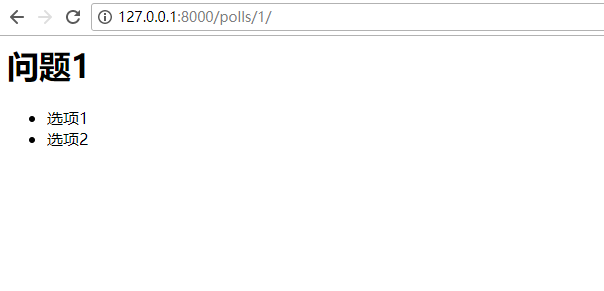继上篇django2.0入门教程第二节,介绍了对django2.0模型类models的操作,本篇主要讲视图views和模板template
django的视图用于处理url请求,并将响应的数据传递到模板,最终浏览器将模板数据进行渲染显示,用户就得到了想要的结果
作为一个简易的投票系统, 除了index(主页), 还需要detail(详情页), results(结果页), vote(投票页) 这些视图。
增加视图:polls/views.py
#_*_coding:utf8_*_
from django.shortcuts import HttpResponse
def index(request):
return HttpResponse("你好,欢迎来到投票系统的主页")
def detail(request, question_id):
return HttpResponse('你正在查看问题%s' % question_id)
def results(request, question_id):
response = '你正在查看问题%s的结果'
return HttpResponse(response % question_id)
def vote(request, question_id):
return HttpResponse('你正在给问题%s投票' % question_id)
配置url:polls/urls.py
#_*_coding:utf8_*_
from django.urls import path
from . import views
urlpatterns = [
# /polls/
path('', views.index, name='index'),
# /polls/1/
path('/', views.detail, name='detail'),
# /polls/1/results/
path('/results/', views.results, name='results'),
# /polls/1/vote/
path('/vote/', views.vote, name='vote'),
]
url访问:
http://127.0.0.1:8000/polls/
你好,欢迎来到投票系统的主页
http://127.0.0.1:8000/polls/1/
你正在查看问题1
http://127.0.0.1:8000/polls/1/results/
你正在查看问题1的结果
http://127.0.0.1:8000/polls/1/vote/
你正在给问题1投票
这样的视图内容过于简略粗糙, 在后台添加多一些数据,供后续调用:
通过视图直接返回的数据,显示格式很单一,要想显示丰富的数据形式,就需要引用模板,用独立的模板文件来呈现内容。
新增模板:polls/templates/polls/index.html
{% if latest_question_list %}
{% for question in latest_question_list %}
- {{question.question_text}}
{% endfor %}
{% else %}
问题为空
{% endif %}
修改视图: polls/views.py 传递变量给模板
#_*_coding:utf8_*_
from django.shortcuts import HttpResponse
from django.template import loader
from .models import Question
def index(request):
latest_question_list = Question.objects.order_by('-pub_date')[:5]
template = loader.get_template('polls/index.html')
context = {'latest_question_list': latest_question_list}
return HttpResponse(template.render(context, request))
访问:http://127.0.0.1:8000/polls/
使用便捷写法--render()函数:
from django.shortcuts import render
from .models import Question
def index(request):
latest_question_list = Question.objects.order_by('-pub_date')[:5]
context = {'latest_question_list': latest_question_list}
return render(request, 'polls/index.html', context)
开发中,直接使用render()即可,尽可能精简代码
详情页的展示:
polls/views.py
from django.http import Http404
from django.shortcuts import render
from .models import Question
# ...
def detail(request, question_id):
try:
question = Question.objects.get(pk=question_id)
except Question.DoesNotExist:
raise Http404('问题不存在')
return render(request, 'polls/detail.html', {'question': question})
新增详情页:polls/templates/polls/detail.html
{{ question }}
http://127.0.0.1:8000/polls/3/
问题3
访问不存在的问题id时,会报404
http://127.0.0.1:8000/polls/4/
404页面抛出的便捷写法:get_object_or_404()
polls/views.py
from django.shortcuts import render, get_object_or_404
from .models import Question
# ...
def detail(request, question_id):
question = get_object_or_404(Question, pk=question_id)
return render(request, 'polls/detail.html', {'question': question})
详情页输出关联数据表:
{{ question.question_text }}
{% for choice in question.choice_set.all %}
- {{ choice.choice_text }}
{% endfor %}
将问题下有关联选项一并输出:
去掉url的硬编码格式
原本index.html的url定义形式是这样的:
{{question.question_text}}
这种写法属于硬编码方式,并不好,因为一旦详情页的url改变,就要去改变相应的html文件,如果html文件有很多处都引用了,逐一排查需要耗费相当多时间。将url改成以下形式即可实现自动转换:
{{question.question_text}}
修改url配置:
将polls/urls.py的详情页url由:path('改为:path('specifics/
此时,index.html的url会自动由 http://127.0.0.1:8000/polls/1/ 转为 http://127.0.0.1:8000/polls/specifics/1/
url的命名空间
现实项目中,一个django项目是会有多个应用的,为了将这些应用进行区分,需要使用命名空间
#_*_coding:utf8_*_
from django.urls import path
from . import views
app_name = 'polls'
urlpatterns = [
path('', views.index, name='index'),
path('/', views.detail, name='detail'),
path('/results/', views.results, name='results'),
path('/vote/', views.vote, name='vote'),
]
将index.html的url生成代码加上命名空间:
{{question.question_text}}
源码下载
相关源码包
如果对django2.0教程感兴趣,请关注我的,持续更新中...



